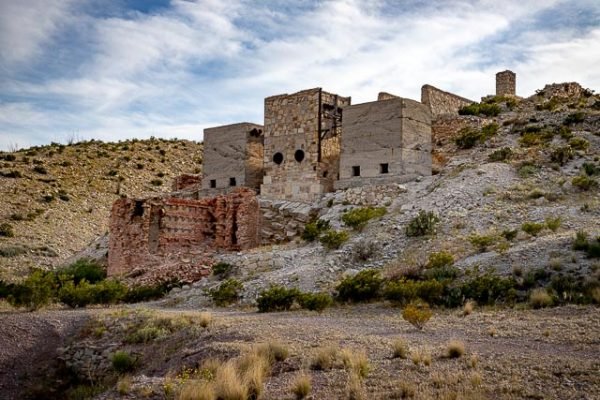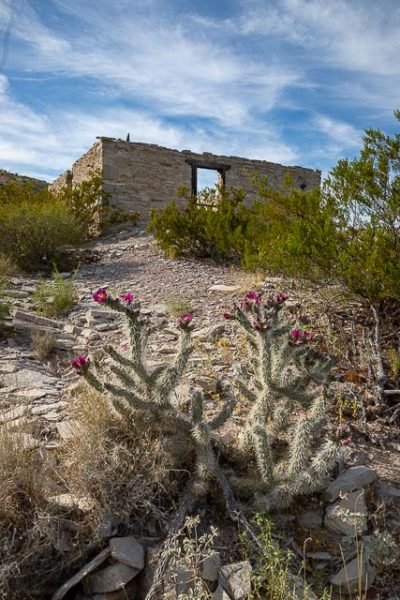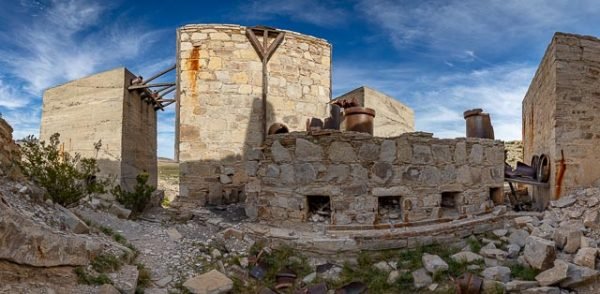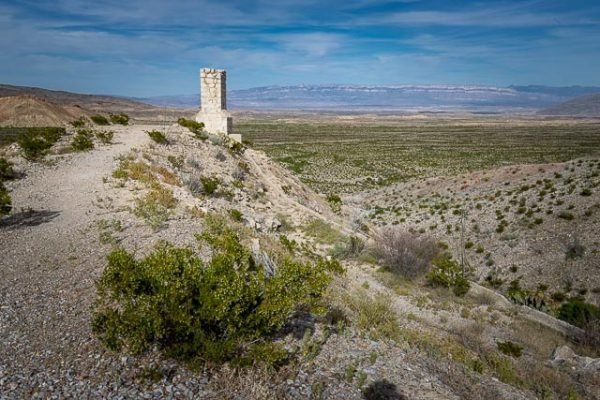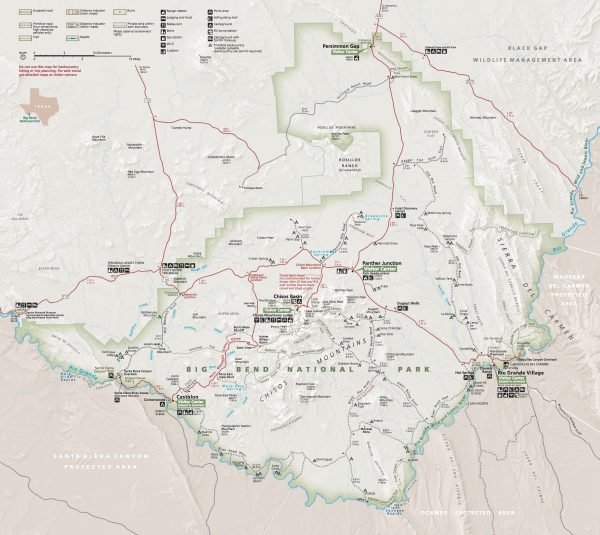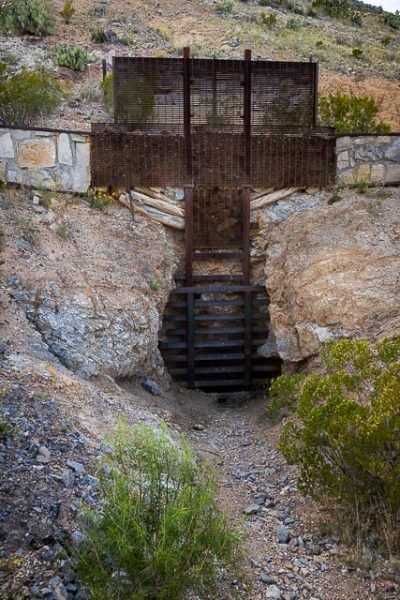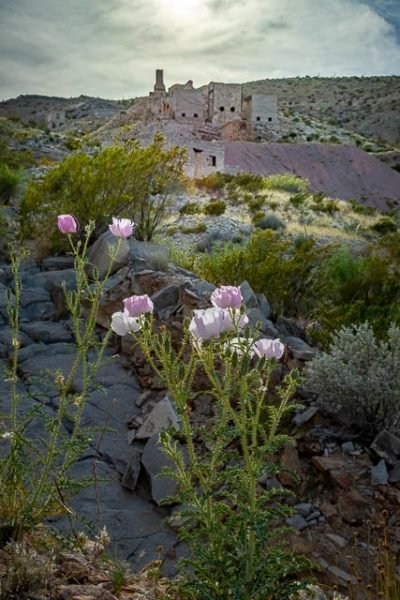Mariscal Mine Big Bend National Park
The Mariscal Mine once bustled as the center of the Big Bend quicksilver mining economy. From 1900 to 1943, Mariscal Mine produced 1,400 seventy-six pound flasks of mercury – nearly one quarter of the total produced in the United States! Now deserted, the mine and surroundings once provided the people who lived here an income, a community, and a home.
Farmer Martin Solis discovered the bright red mercury-bearing ore called cinnabar near his farm in 1900, and set the history of Mariscal Mine in motion. Shortly thereafter, local U.S. Customs agent and Boquillas, TX, store owner Ed Lindsay filed the first mining claim on Mariscal Mountain. The Lindsay Mine produced some ore between 1900 and 1905, but Lindsay encountered numerous difficulties. Transporting the cinnabar ore 30 miles by mule was costly and a lawsuit challenged his ownership of the property. Subsequently, Lindsay sold his interests to Isaac Sanger of Dallas in November 1905. Only four years later, Sanger’s Texas Almaden Mining company closed due to a worldwide economic depression.
World War I created demand for mercury because it was required in the manufacture of blasting caps and bomb detonators. Subsequently, W. K. Ellis, a Midwestern inventor, purchased the mine in 1917. He built a four compartmnet ore bin that fed into three stationary retorts, or glazed tubes. The Ellis Mine produced 894 flasks of mercury, but when prices plummeted ast the end of the war, Ellis wisely sold the mine to William “Billy” Burcham. Sturctures from this early phase of cinnabar ore processing are visible at the lowest level of the mine complex.
In the summer of 1919, Burcham and several New York financiers formed the Mariscal Mining Company. Naming the company after the mountain it rests upon, Burcham opened the mine and invested in modern equipment and refining methods to increase efficiency and production. The large Scott Furnace and elaborate concrete condenser system that stands above it are the remains of the Mariscal Mining Company. Unfortunately, the system proved to be not so modern or as efficient as hoped. The declining mercury market doomed the mine to failure, and it closed in 1923.
At the beginning of World War II, Burcham reopened the Mariscal Mine under the name of the Vivianna Mining Company. He installed a 30-ton Gould rotary furnace. The high prices he anticipated for mercury did not materialize, and the mine closed for the final time in 1943, just a year before the establishment of Big Bend National Park. All items of value were sold at auction. Ironically, some of the mercury-soaked bricks from the Scott Furnace were processed, yielding a considerable quantity of mercury.
Life at the Mine
Between 1919 and 1923, Mariscal Mine employed 20-40 people. The miners were Mexican citizens who had walked into Texas to escape the Mexican Revolution. Only the manager, foreman, and brick-kiln specialist were American.
Newly-arrived miners usually lived in brush shelters at the foot of Mariscal Mountain. As time permitted, they gathered rocks and built houses. Their wives planted and cared for small vegetable gardens near Fresno Creek. Most of the ruins you see today were one to three room houses, built between 1919 and 1923. During 1942-43, the Vivianna Mining Company built ten concrete and stucco homes for the miners. Ironically, they were probably never occupied as the mine never realized its potential.
Water for the community was obtained from shallow, hand-dug wells along Fresno Creek, about a mile north of the mine. Mexican freighters also hauled large quantities of water to the mine from Glenn Spring, ten miles north.
Working six days per week, experienced miners were paid up to $1.50 per 10-hour shift. Less-skilled laborers earned $1-$1.25. Most of the miners’ earnings returned to the mine owners via the company store, which provided supplies. Each employee also contributed $1 per paycheck to support the resident doctor in return for medical care.
Mariscal Mine and its community depended upon the Mexican freighters for all their supplies, including firewood for the Scott Furncace. The freighters hauled extracted mercury from the Mine to the railhead at Marfa for $1 per flask.
The work of digging cinnabar ore by pick and shovel from the depths of Mariscal Mine and then heating it to render mercury was both difficult and unhealthy. Many miners succumbed to mercury poisoning from handling the ore. Those who worked around the Scott Furnace often “salivated,” meaning they produced abnormal amounts of saliva. Most veteran furnace men had no teeth and developed chronic respiratory problems from mercury fumes.
Where it is:
Mariscal Mine is located on the northern end of Mariscal Mountain, deep in the interior of Big Bend National Park. Easiest access to the area is via the River Road east, which begins just five miles west of Rio Grande Village.
High clearance or four-wheel drive vehicles are recommended for traveling this dirt road; check with a park ranger for current road conditions before setting out. Allow at least one-half day for this excursion.
Maps:
Interactive Google Map
Use the map + – controls to zoom in and out, click and drag the to move the map, use the Map drop-down to change to “Map”, “Satellite”, “Hybrid”, or “Terrain” views. Drag the little man icon from the upper left corner to a map location for street level view.
Map of Remaining Structures
GPS:
29°5’41.086″ N 103°11’19.476″ W
Cost:
- Entrance Passes
All federal lands passes are issued and accepted at Big Bend National Park. Passes are non-transferable. - Vehicle: $30
Admits one private, non-commercial vehicle (15 passenger capacity or less); valid for 7 days. - Motorcycle: $25
Admits one non-commercial motorcycle; valid for 7 days. - Individuals: $15
Admits one individual. Typically used for bicyclists and pedestrians; valid for 7 days. - Big Bend Annual Pass: $55 (good for one year from purchase date)
Covers entrance fees to Big Bend National Park. Pass is available at Big Bend National Park entrance stations or any Visitor Center. Pass is non-transferable.
Park entrances are always open and you can arrive at any hour, but entrance fee stations and visitor centers may be closed after normal business hours.
Facilities:
There are no facilities anywhere near the mine, the closest facilities are at Rio Grande Village.
Location Contact Information:
Mariscal Mine Big Bend National Park Photo Gallery
Click Here for full page gallery
More Photographic Destinations in Texas:
Interactive Google Map
Use the map + – controls to zoom in and out, use the Map drop-down to change to “Map”, “Satellite”, “Hybrid”, or “Terrain” views. Drag the little man icon from the upper left corner to a map location for street level view. Click on a pushpin for more information about the Photographic Destination, then click on the title to go to the location page.
Click Here for Photographic Destinations by State
